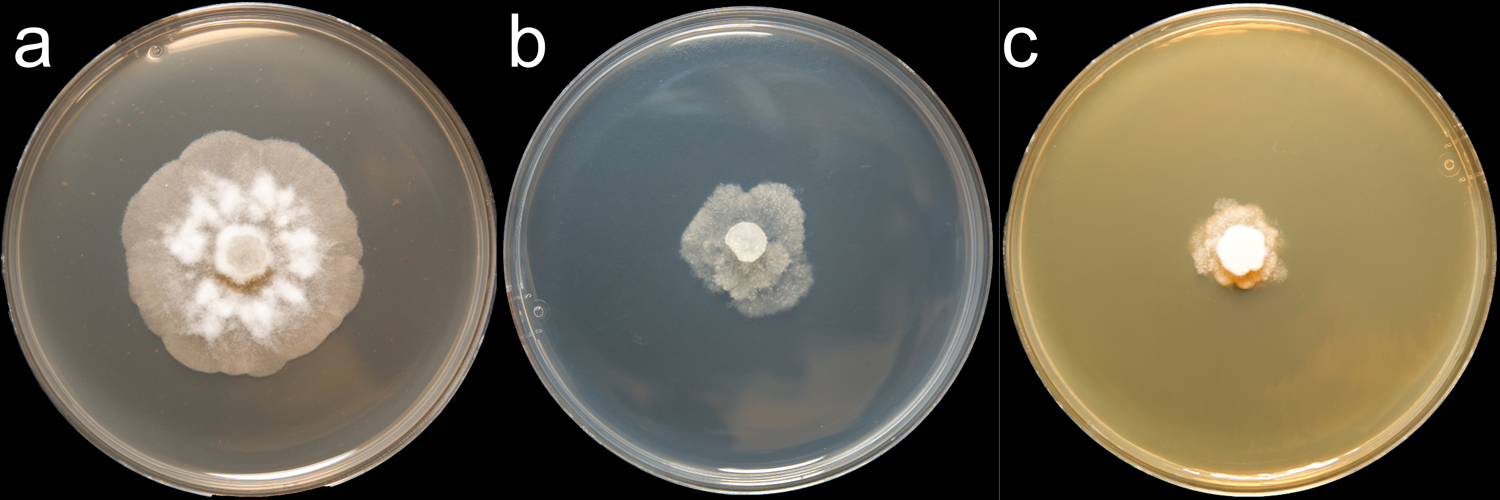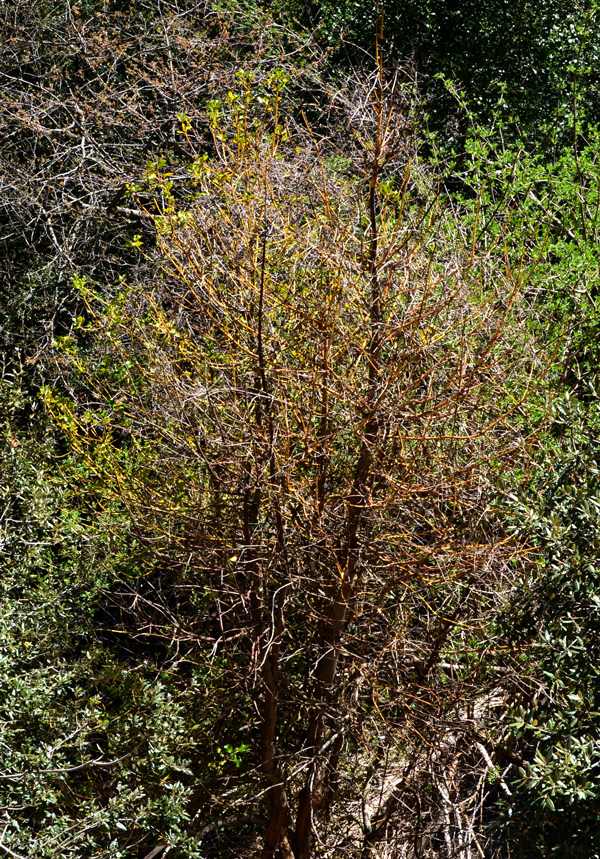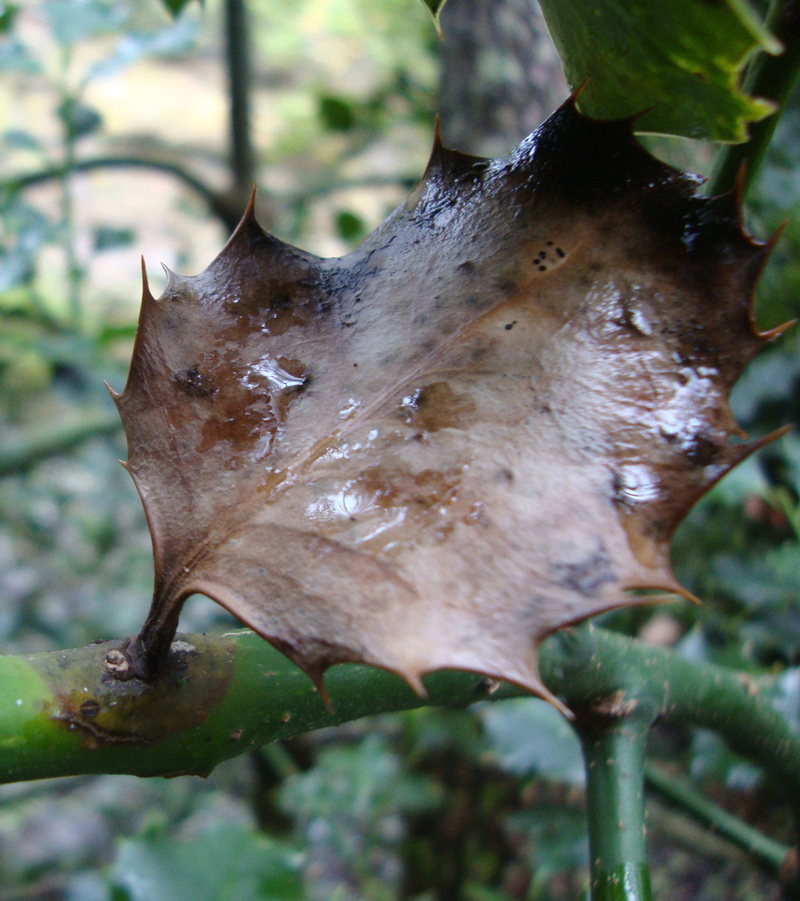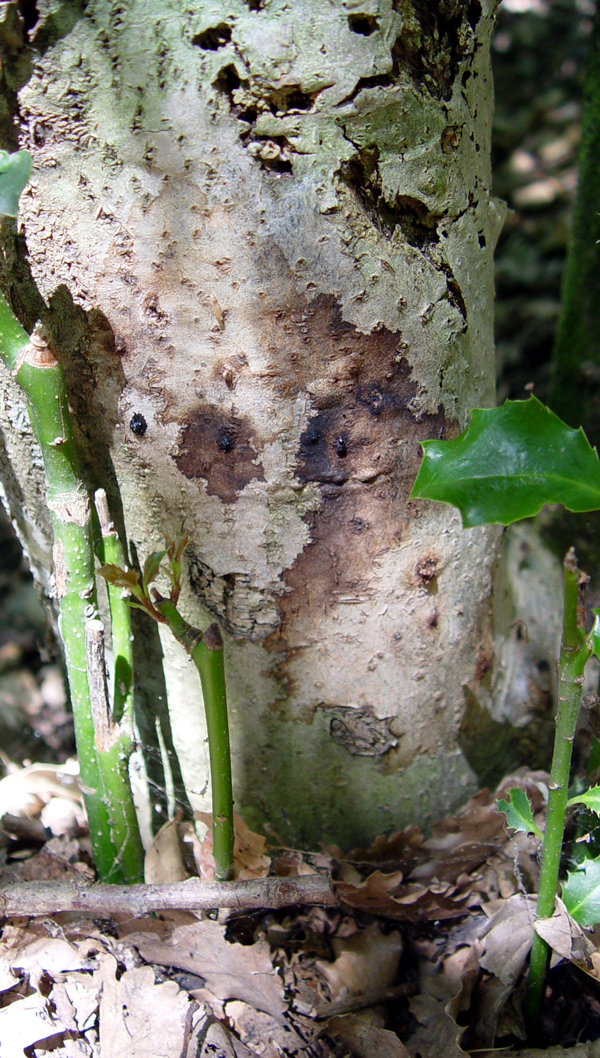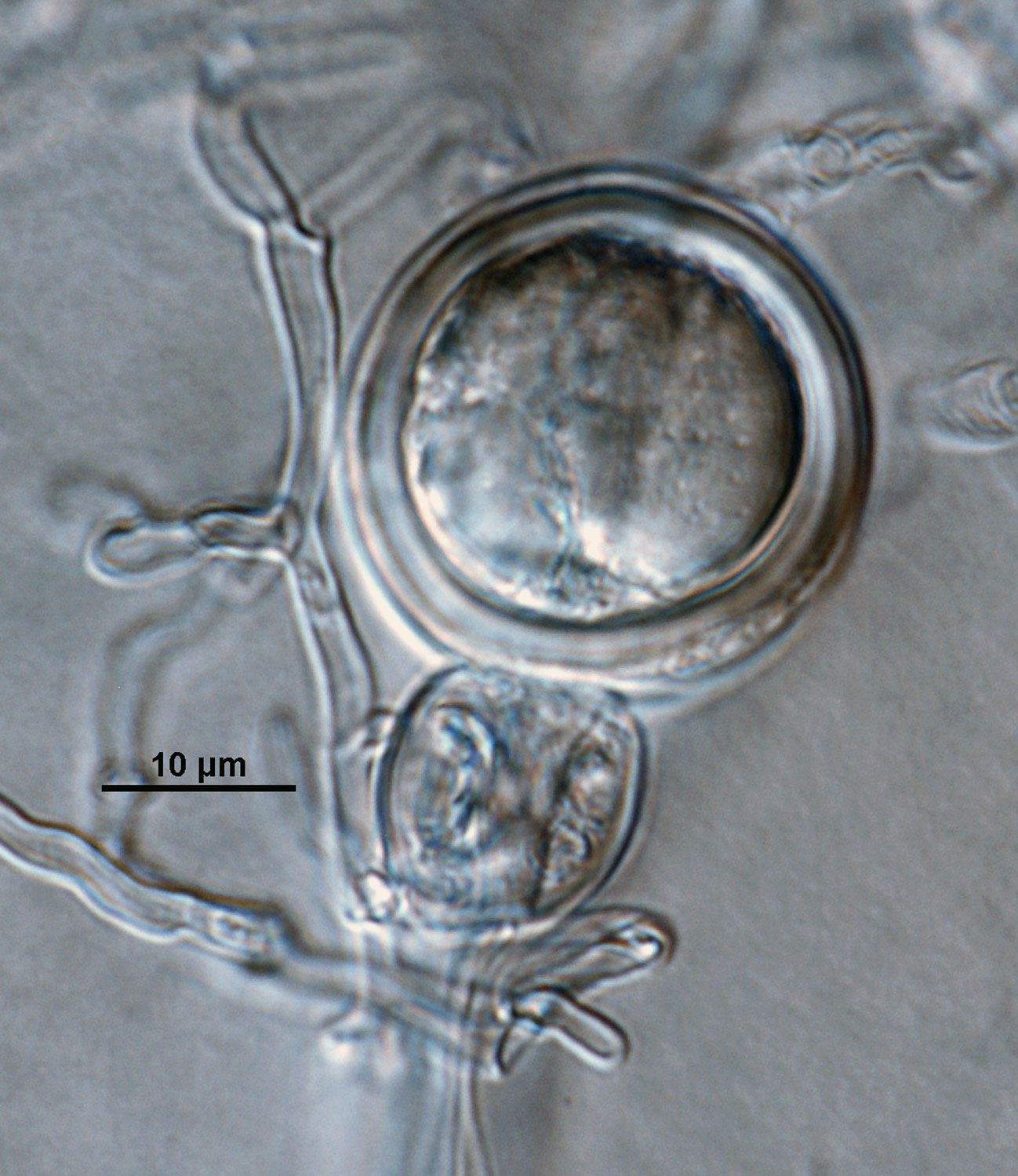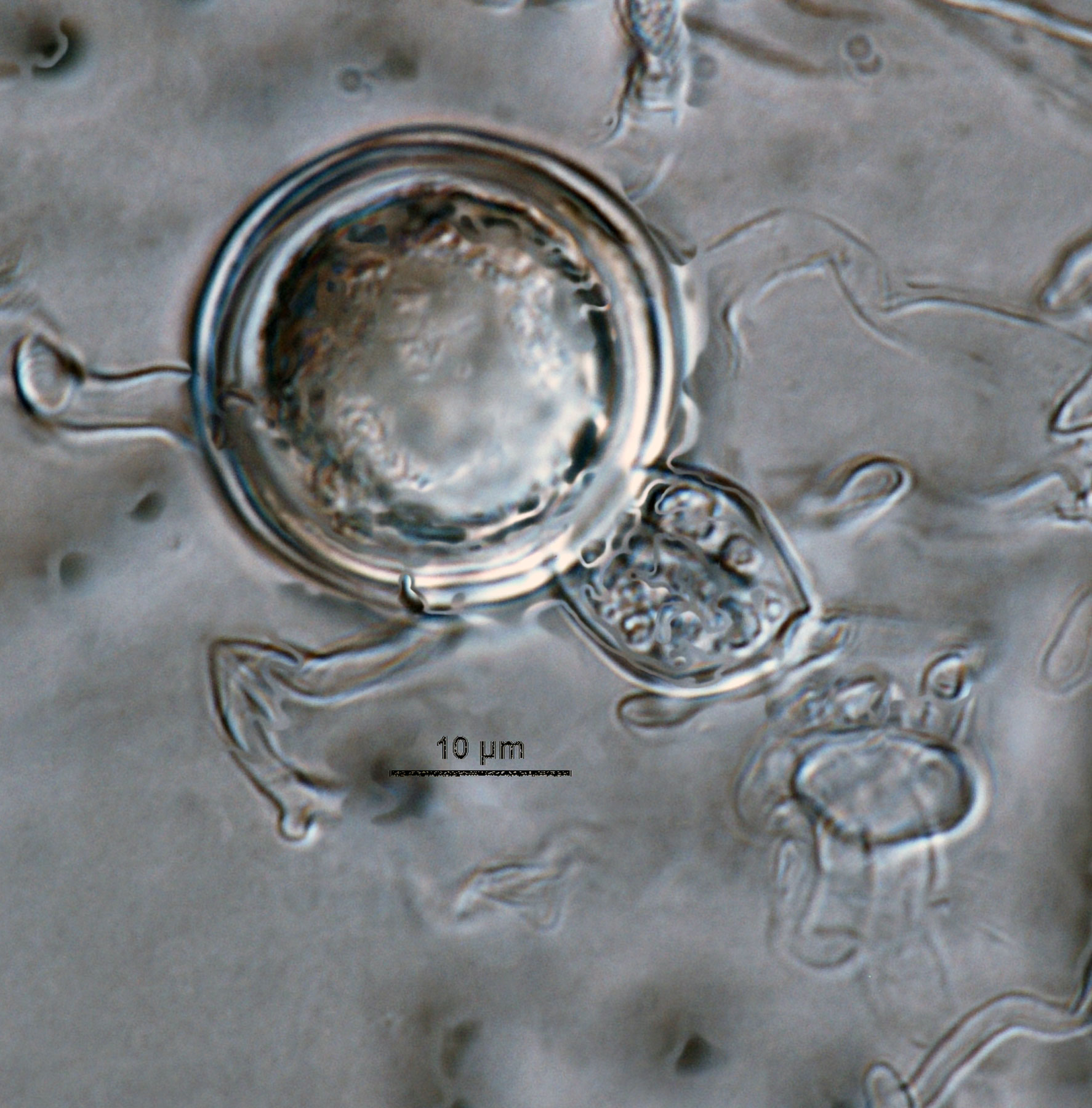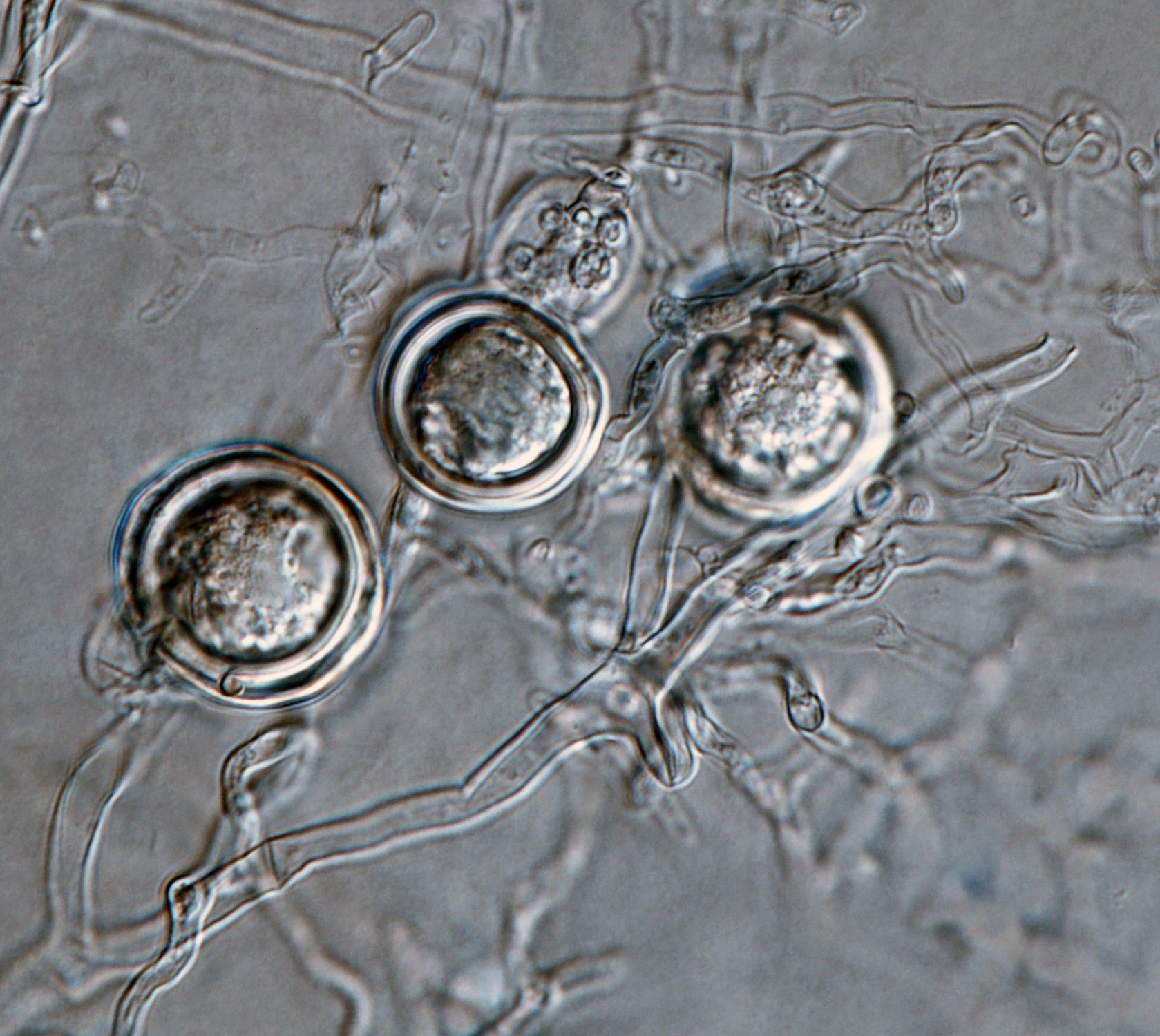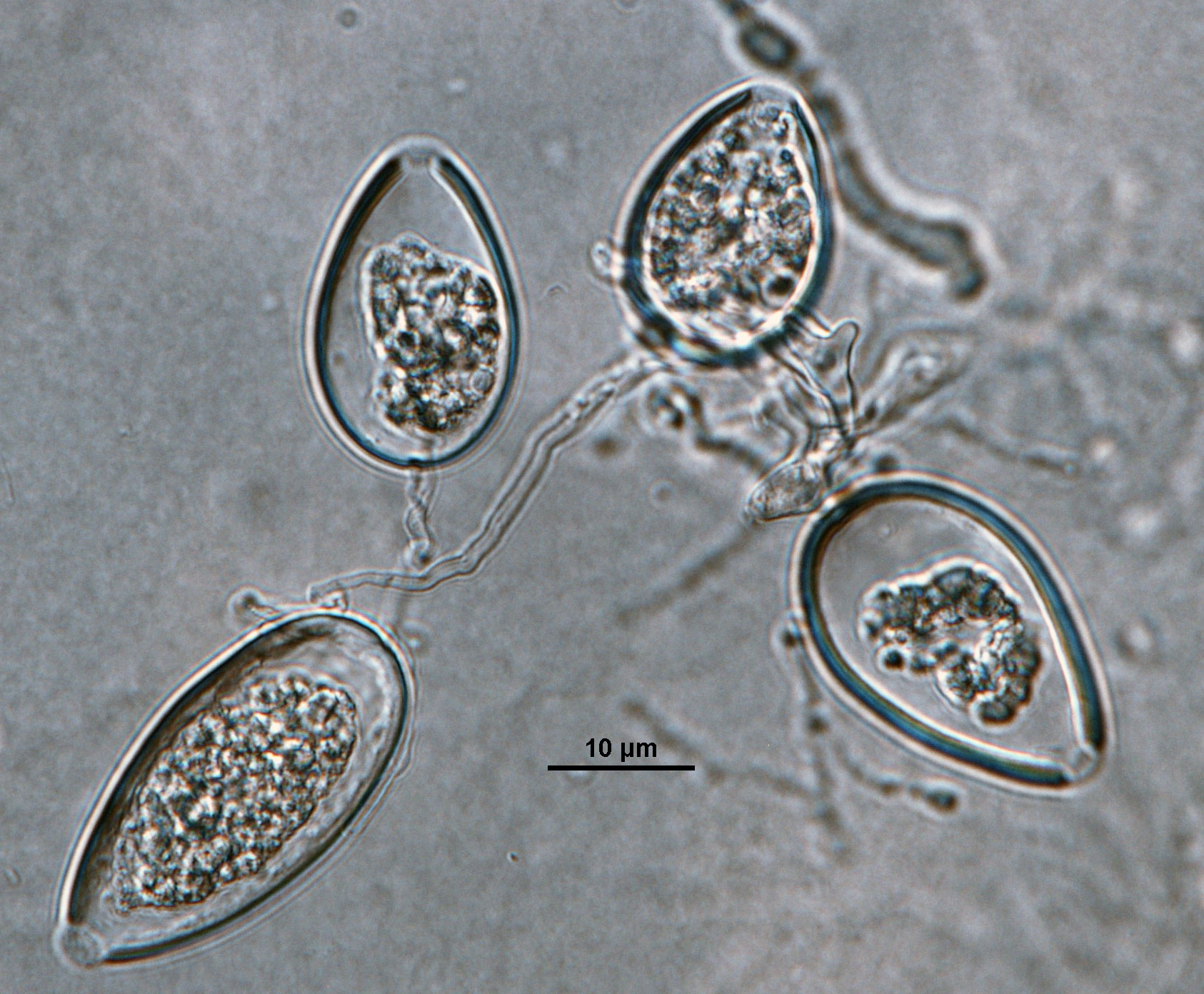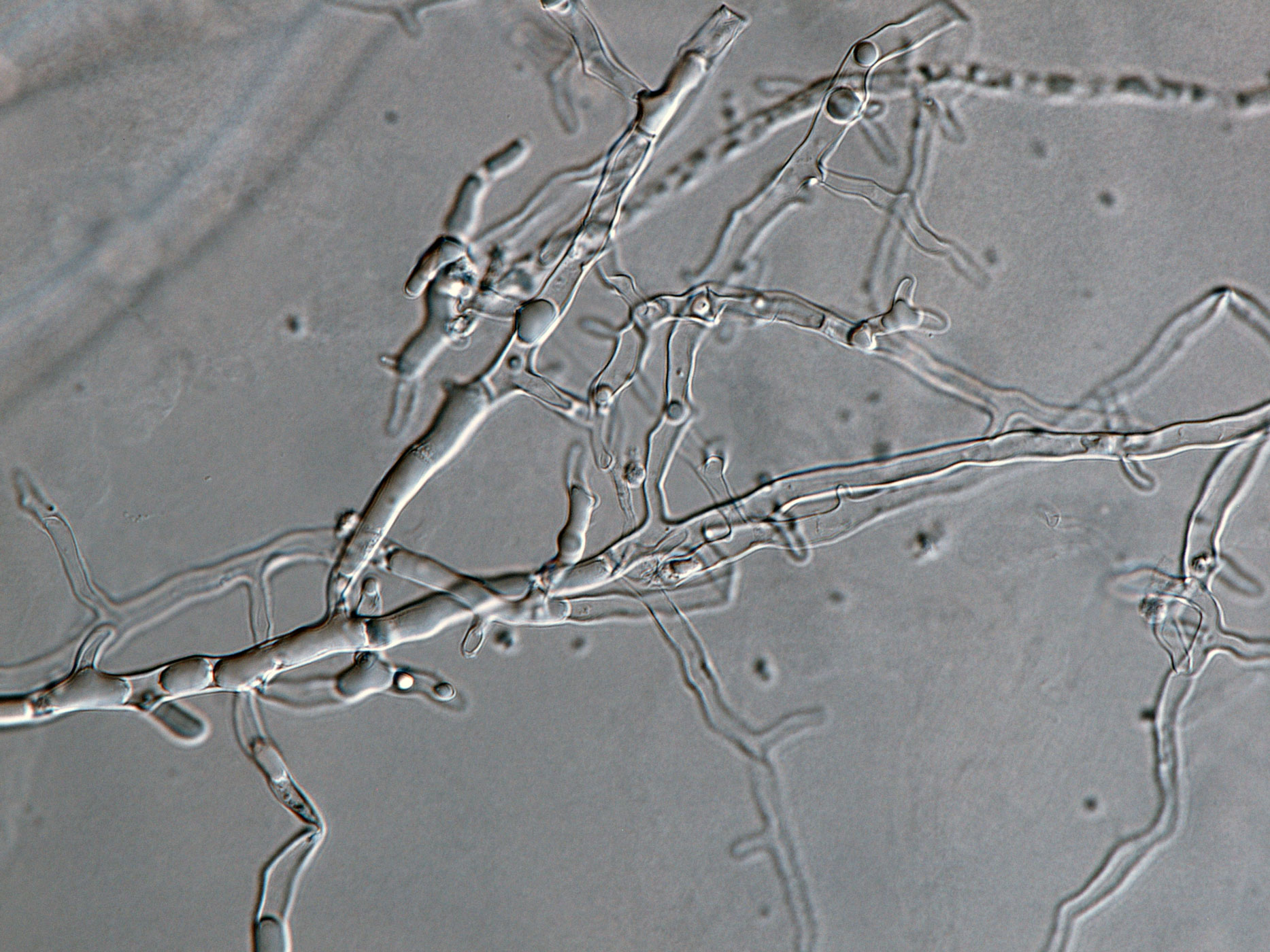Phytophthora ilicis (in progress - Abad et al. 2023b)
|
Phytophthora spp. in Clade 3: portion of the seven-loci ML phylogeny featuring the type cultures of 212 described species (by T. Bourret). Notice the position of P. ilicis selected specimen CBS 149896 = S&T BL 39. Gloria Abad, USDA S&T.
|
|
Phytophthora spp. in Clade 3: Morphological Tabular key (PDF) and Tabular key legends (PDF) in IDphy2 KEY SECTION. Notice the data of P. ilicis selected specimen CBS 149896 = S&T BL 39. Gloria Abad, USDA S&T.
|
|
Phytophthora ilicis (CPHST BL 39) colonies of a selected specimen grown for 7 days on (a) V8® Agar, (b) potato dextrose agar, and (c) malt extract agar; photo by Krysta Jennings and Leandra Knight, USDA-APHIS-PPQ |
|
Phytophthora ilicis (selected specimen CPHST BL 39) asexual phase:(a) semipapillate persistent sporangia with pedicels and (b, c) knobby mycelia; photos by Gloria Abad, USDA-APHIS-PPQ. |
|
Phytophthora ilicis (selected specimen CPHST BL 39) sexual phase: plerotic oospores with smooth-walled oogonia with amphigynous antheridia; photos by Gloria Abad, USDA-APHIS-PPQ. |
|
canopy defoliation on Ilex aquifolium caused by Phytophthora ilicis in Sardinia, Italy; photo by Bruno Scanu and Antonio Franceschini. Università degli Studi di Sassari, Italy |
|
fresh lesion around axillary node of an Ilex aquifolium leaf caused by Phytophthora ilicis in Sardinia, Italy; photo by Bruno Scanu and Antonio Franceschini. Università degli Studi di Sassari, Italy |
|
bleeding lesion on the stem of Ilex aquifolium caused by Phytophthora ilicis in Sardinia, Italy; photo by Bruno Scanu and Antonio Franceschini. Università degli Studi di Sassari, Italy |
|
Phytophthora ilicis (selected specimen CPHST BL 39) sexual phase: plerotic oospore with smooth-walled oogonium with amphigynous antheridium; photo by Gloria Abad, USDA-APHIS-PPQ. |
|
Phytophthora ilicis (selected specimen CPHST BL 39) sexual phase: plerotic oospore with smooth-walled oogonium with amphigynous antheridium; photo by Gloria Abad, USDA-APHIS-PPQ. |
|
Phytophthora ilicis (selected specimen CPHST BL 39) sexual phase: plerotic oospore with smooth-walled oogonium with amphigynous antheridium; photo by Gloria Abad, USDA-APHIS-PPQ. |
|
Phytophthora ilicis (selected specimen CPHST BL 39) asexual phase: semipapillate persistent sporangia with pedicels; photo by Gloria Abad, USDA-APHIS-PPQ. |
|
Phytophthora ilicis (selected specimen CPHST BL 39) asexual phase: knobby mycelia; photo by Gloria Abad, USDA-APHIS-PPQ. |
|
Phytophthora ilicis (selected specimen CPHST BL 39) asexual phase: knobby mycelia; photo by Gloria Abad, USDA-APHIS-PPQ. |
Name and publication
Phytophthora ilicis Buddenh. & Roy A. Young (1957)
Buddenhagen IW and Young RA. 1957. A leaf twig disease of English holly caused by Phytophthora ilicis n.sp. Phytopathology 47: 95–101.
Nomenclature
Mycobank
Typification
from Buddenhagen and Young (1957)
Type: UNITED STATES OF AMERICA, Oregon, from leaves and stems of Ilex aquifolium L. collected on November 1954
Ex-type: LOST
Well-authenticated specimen selected by Gloria Abad:
CPHST BL 39 = P3939 WPC, from Ilex aquifolium, CANADA
CPHST BL 103 = P6099 WPC, from Ilex aquifolium, UNITED STATES OF AMERICA
Selected specimen(s) in other collections
(SE) CBS 149896, NRRL 64374, MYA-3897, WPC P3939, S&T BL 39 (Abad), p113 (Gallegly), 18.1 (Ho)
Molecular identification
Voucher sequences for barcoding genes (ITS rDNA and COI) of the selected specimen (see Molecular protocols page)
Phytophthora ilicis isolate CPHST BL 39 (= P3939 WPC) = ITS rDNA MG865511, COI MH136905
Phytophthora ilicis isolate CPHST BL 103 (= P6099 WPC) = ITS rDNA MG865510, COI MH136904
Voucher sequences for Molecular Toolbox with seven genes (ITS, β-tub, COI, EF1α, HSP90, L10, and YPT1
(see Molecular protocols page) (In Progress)
Voucher sequences for Metabarcoding High-throughput Sequencing (HTS) Technologies [Molecular Operational Taxonomic Unit (MOTU)]
(see Molecular protocols page) (In Progress)
Sequences with multiple genes for selected specimen in other sources
- NCBI: Phytophthora ilicis CPHST BL 39
- NCBI: Phytophthora ilicis CPHST BL 103
- NCBI: Phytophthora ilicis P6099
- EPPO-Q-bank: Phytophthora ilicis
- BOLDSYSTEMS: Phytophthora ilicis (barcoding COI & ITS)
Position in multigenic phylogeny with 7 genes (ITS, β-tub, COI, EF1α, HSP90, L10, and YPT1)
Clade clade:
a taxonomic group of organisms classified together on the basis of homologous features traced to a common ancestor
3
Morphological identification
Colonies and cardinal temperatures
Colony colony:
assemblage of hyphae which usually develops form a single source and grows in a coordinated way
morphology in V8-A and PDA with light stellate pattern, in MEA with slow growth. The minimum temperature for growth is 5°C, optimum 20°C, and maximum 25°C.
Conditions for growth and sporulation
Sporangia produced after mats growing in pea broth are transfered to water cultures and incubated for 5 days at 20°C.
Asexual phase
Sporangia nonpapillate nonpapillate:
pertaining to the production of a non-distinct, or inconspicuous, papilla at the distal end of the sporangium (cf. papillate and semipapillate)
and semipapillatesemipapillate:
pertaining to the production of shallow having papilla that are not well developed, shallow and less nipple-like than fully papillate structures
; sometimes caducouscaducous:
pertaining to sporangia that become dislodged readily (i.e. deciduous) and separate from the sporangiophore (cf. persistent)
with medium to long pedicels (5–25 μm); ovoidovoid:
egg-shaped, with the widest part at the base of the sporangium and the narrow part at the apex
, obpyriformobpyriform:
inversely pear-shaped, i.e. with the widest part at the point of attachment (cf. pyriform)
(25–45 μm long x 15–28 μm wide); originated in unbranched or in simple sympodial sporangiophores. Hyphal swellings absent. ChlamydosporesChlamydospores:
an asexual spore with a thickened inner wall that is delimited from the mycelium by a septum; may be terminal or intercalary, and survives for long periods in soil
rare.
Sexual phase
Homothallic. OogoniaOogonia:
the female gametangium in which the oospore forms after fertilization by the antheridium
smooth-walled (25–35 μm diam.), presenting tapered bases; antheridia amphigynous; oospores plerotic plerotic:
pertaining to an oospore that fills the oogonium (cf. aplerotic)
and apleroticaplerotic:
pertaining to a mature oospore that does not fill the oogonium; i.e. there is room left between the oospore wall and oogonium wall (cf. plerotic)
.
Specimen(s) evaluated
Phytophthora ilicis CPHST BL 103 = P6099 (World Phytophthora Collection)
Phytophthora ilicis CPHST BL 39 = P3939 (World Phytophthora Collection)
Hosts and distribution
Distribution: Europe (Italy, France, UK), North America (Canada, USA)
Substrate: leaves, twigs
Disease note: leaf and twig blight, bleeding canker
Host: Ilex aquifolium, Ilex spp. (Aquifoliaceae)
Retrieved January 31, 2018 from U.S. National Fungus Collections Nomenclature Database.
Additional references and links
Phytophthora ilicis in OSU Phytophthora Online course: Training for Nursery Growers. Oregon State University.
- SMML USDA-ARS: Phytophthora ilicis
- EPPO Global Database: Phytophthora ilicis
- Forest Phytophthoras of the world: Phytophthora ilicis
- CABI Digital Library: Phytophthora ilicis
- Encyclopedia of Life (EOL): Phytophthora ilicis
- Index Fungorum (IF): Phytophthora ilicis
- Google All Phytophthora ilicis
- Google Images Phytophthora ilicis
- Google Scholar Phytophthora ilicis
Fact sheet author
Z. Gloria Abad, Ph.D., USDA-APHIS-PPQ-S&T Plant Pathogen Confirmatory Diagnostics Laboratory (PPCDL), United States of America.

